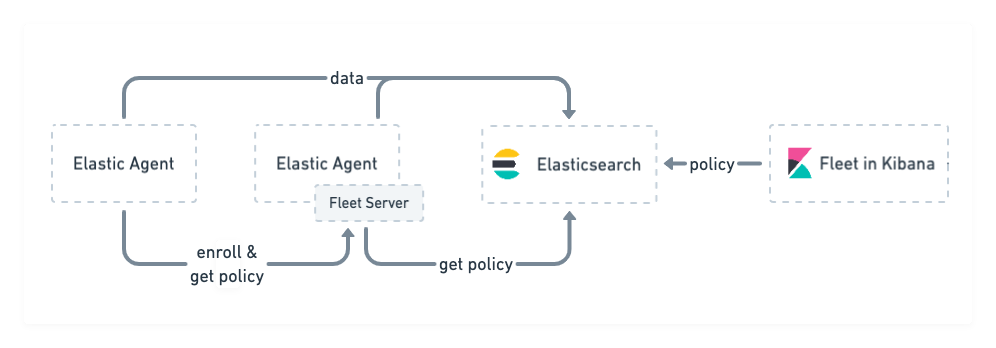Fleet Server
editFleet Server
editFleet Server is a component of the Elastic Stack used to centrally manage Elastic Agents. It’s launched as part of an Elastic Agent on a host intended to act as a server. One Fleet Server process can support many Elastic Agent connections, and serves as a control plane for updating agent policies, collecting status information, and coordinating actions across Elastic Agents.
Fleet Server is the mechanism Elastic Agents use to communicate with Elasticsearch:
- When a new agent policy is created, it’s saved to Elasticsearch.
- To enroll in the policy, Elastic Agents send a request to Fleet Server, using the enrollment key generated for authentication.
- Fleet Server receives the request and gets the agent policy from Elasticsearch, then ships the policy to all Elastic Agents enrolled in that policy.
- Elastic Agent uses configuration information in the policy to collect and send data to Elasticsearch.
- Elastic Agent checks into Fleet Server for updates, maintaining an open connection.
- When a policy is updated, Fleet Server retrieves the updated policy from Elasticsearch and sends it to the connected Elastic Agents.

Fleet Server runs as a subprocess inside an Elastic Agent. The agent uses a special policy that describes the Fleet Server configuration. In large scale self-managed deployments or on hosted Elasticsearch Service on Elastic Cloud, Fleet Server is typically run as a dedicated Elastic Agent communication host, but you can optionally use it for data collection on self-managed clusters. For more details, refer to Fleet Server scalability.
Service account
editFleet Server uses a service token to communicate with Elasticsearch, which contains
a fleet-server service account. Each Fleet Server can use its own service
token, and you can share it across multiple servers (not recommended). The
advantage of using a separate token for each server is that you can invalidate
each one separately.
You can create a service token by either using the Fleet UI or the Elasticsearch API. For more information, refer to Add a Fleet Server.
Learn more
editTo learn more about adding and scaling Fleet Server, refer to: